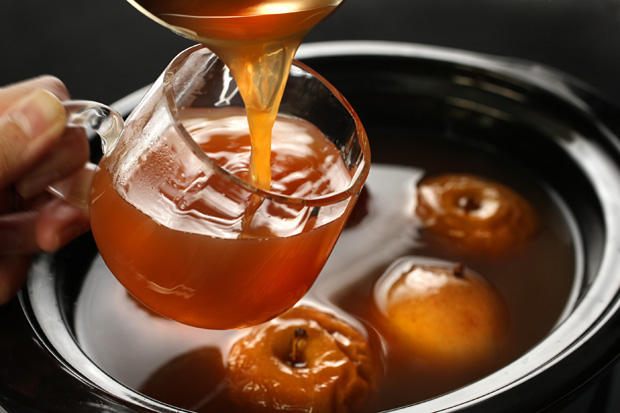Christmas Wassail Bowl
My Mom’s (Danna Doty-Patterson-Donovan) Christmas Wassail Bowl
The perfect beverage to warm up your holiday celebrations! This Christmas Wassail Bowl recipe, crafted by my mom, is a festive, aromatic punch that fills the house with the scent of apples, spices, and baked oranges. It’s the best wassail bowl I’ve ever found, and it has been a family favorite since 2008.
- Prep Time: 15 minutes (includes studding the oranges with cloves)
- Cook Time: 35 minutes (30 minutes to bake the oranges, plus 5 minutes for simmering the wassail)
- Total Time: 50 minutes
- Yield: About 20 cups (serves 20) 1x
- Category: Beverages
- Method: Simmering
- Cuisine: Traditional English
Ingredients
- 6 cups apple cider or juice (Hood River Apples are best for a Northwest twist)
- 1 cinnamon stick
- ¼ tsp nutmeg
- ¼ tsp clove
- 3 tsp lemon juice
- 1 tsp lemon rind
- 1 can (1lb 4oz) unsweetened pineapple juice
- 3 whole oranges, studded with whole cloves
- Pineapple rings (optional, for garnish)
- Cinnamon sticks (for stirring)
Instructions
- Prepare the Oranges: Preheat the oven to 325°F. Stud the whole oranges with cloves, spacing them about ½ inch apart. Place the oranges in a baking dish with a little water, just enough to cover the bottom. Bake for 30 minutes.
- Heat the Cider: In a large pan, heat the apple cider and cinnamon stick. Bring to a boil, then simmer covered for 5 minutes.
- Add Remaining Ingredients: Stir in the nutmeg, clove, lemon juice, lemon rind, and pineapple juice. Simmer uncovered for another 5 minutes.
- Serve: Pour the wassail into a punch bowl and float the baked oranges on top. Add pineapple rings and cinnamon sticks for garnish and serve hot. Keep warm over low heat or heat in batches as guests arrive.
Pro Tip: Use cinnamon sticks as stirrers to enhance the festive experience!
Notes
The wassail bowl has a rich history rooted in English tradition, particularly linked to the holiday season. The word wassail itself comes from the Old English phrase waes hael, meaning “be in good health” or “good cheer.” Wassailing traditionally involved a communal bowl filled with a warm, spiced drink, shared during celebrations to wish health and prosperity to participants.
Origins and Traditions:
- Pagan Roots: Wassail was originally part of pre-Christian pagan rituals in the UK, where people would gather around an apple orchard to perform wassailing ceremonies in hopes of ensuring a good apple harvest. The beverage often included cider, which made sense in regions where apple orchards were plentiful.
- Medieval Celebrations: By the medieval period, wassail had evolved into a communal drink used in feasting and caroling. Villagers would go door-to-door, offering a cup of wassail in exchange for gifts, in a custom known as “wassailing,” which eventually morphed into modern-day caroling. The drink was often a blend of ale, cider, or wine with spices, apples, and sugar(
)(
).
- Wassail in the Aristocracy: During the 17th century, wassailing became popular among the upper class, who enjoyed more elaborate wassail recipes involving spiced wine or brandy. The wassail bowl became a symbol of celebration, often made of silver or intricately carved wood and passed around as part of a toasting tradition(
).
- Modern-Day Wassail: In contemporary times, wassail is most associated with the Christmas season, with recipes featuring a mix of warm apple cider or wine, citrus, and various spices like cinnamon, cloves, and nutmeg. It is served in punch bowls, often with baked apples or oranges floating on top, much like the recipe from your blog post.
Symbolism:
The wassail bowl was more than just a festive drink. It symbolized community and shared prosperity. By drinking from the communal bowl, everyone partook in the collective wishes for health and good fortune.
Wassail and the associated ceremonies remind us of the importance of tradition, community, and the way food and drink can bring people together during celebrations.
For more detailed information on the history of wassailing and wassail bowls, check sources like The Spruce Eats or historical articles on English traditions.
Nutrition
- Serving Size: 1 cup
- Calories: ~100 kcal
- Sugar: ~20g
- Sodium: ~10mg
- Fiber: ~1g
- Protein: 0g



Recent Comments